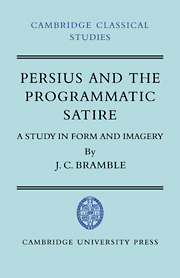Book contents
- Frontmatter
- Contents
- PARENTIBUS OPTIMIS
- Preface
- Abbreviations
- INTRODUCTION
- 1 STYLE AND EXPRESSION IN PERSIUS' FIFTH SATIRE
- 2 THE PROGRAMMATIC SATIRE AND THE METHOD OF PERSIUS I
- 3 THE NATURE AND SOURCES OF PERSIUS' IMAGERY
- 4 PERSIUS' FIRST SATIRE: ANALYSIS
- 5 GRANDEUR AND HUMILITY: JUVENAL AND THE HIGH STYLE
- APPENDIX 1 Accius and Pacuvius at Persius I. 76–8
- APPENDIX 2 Virgil and the moderns at Persius I. 96
- APPENDIX 3 The image of the child in ancient satire and diatribe
- APPENDIX 4 The disclaimer of malice
- TEXT
- TRANSLATION
- 1 INDEX OF MODERN AUTHORS
- 2 INDEX LOCORUM POTIORUM
- 3 INDEX OF IMAGES, TOPICS AND WORDS
5 - GRANDEUR AND HUMILITY: JUVENAL AND THE HIGH STYLE
from PARENTIBUS OPTIMIS
Published online by Cambridge University Press: 05 June 2014
- Frontmatter
- Contents
- PARENTIBUS OPTIMIS
- Preface
- Abbreviations
- INTRODUCTION
- 1 STYLE AND EXPRESSION IN PERSIUS' FIFTH SATIRE
- 2 THE PROGRAMMATIC SATIRE AND THE METHOD OF PERSIUS I
- 3 THE NATURE AND SOURCES OF PERSIUS' IMAGERY
- 4 PERSIUS' FIRST SATIRE: ANALYSIS
- 5 GRANDEUR AND HUMILITY: JUVENAL AND THE HIGH STYLE
- APPENDIX 1 Accius and Pacuvius at Persius I. 76–8
- APPENDIX 2 Virgil and the moderns at Persius I. 96
- APPENDIX 3 The image of the child in ancient satire and diatribe
- APPENDIX 4 The disclaimer of malice
- TEXT
- TRANSLATION
- 1 INDEX OF MODERN AUTHORS
- 2 INDEX LOCORUM POTIORUM
- 3 INDEX OF IMAGES, TOPICS AND WORDS
Summary
Jahn's note on Pers. I. 20 correctly aligns physical hypertrophy with mental crassness: ‘hoc vocat ingentes, ut V. 190, ingentem centurionem, III. 86, multum torosam iuventutem, V. 95, calonem altum, ut animum prae corpore neglectum significet.’ He might have added II. 71 f., quin damus id superis de magna quod dare lance/non possit magni Messallae lippa propago, where size, measured in terms of social importance, is a disqualification from acceptance by the gods, and V. 190, ingens Pulfenius, of an immense centurion amused by philosophy. As for the Horatian background to this fastidiousness about size, we can adduce the striking repetitions, magno magnum and grandes …\grande at Sat. II. 2.39 and 95–6, debunking the appetite for sheer quantity; magni quo pueri magnis e centurionibus orti, I. 6.72–3, an expression of scorn for his insensitive school-mates; the social satire of magno prognatum … magno at I. 2.70–2, and magna … cena at II. 6.104; then the philosophic irony of I. 3.136, magnorum maxime regum. For pinguis in the ironic self-identification of Ep. I. 15.24–5:
pinguis ut inde domum possim Phaeaxque reverti scribere te nobis, tibi nos accredere par est
- Type
- Chapter
- Information
- Persius and the Programmatic SatireA Study in Form and Imagery, pp. 156 - 173Publisher: Cambridge University PressPrint publication year: 1974

